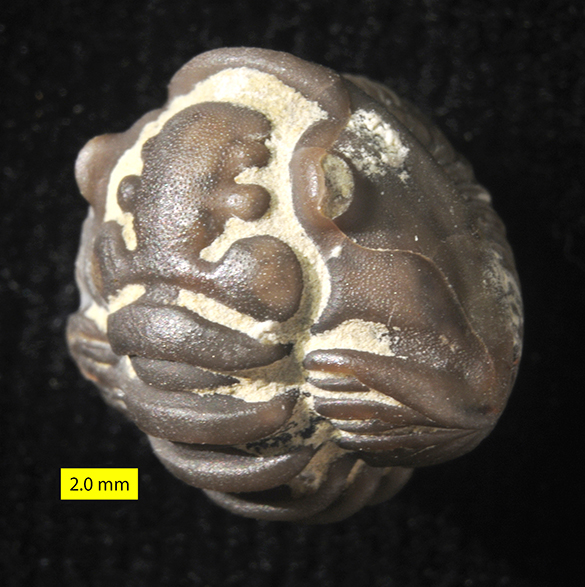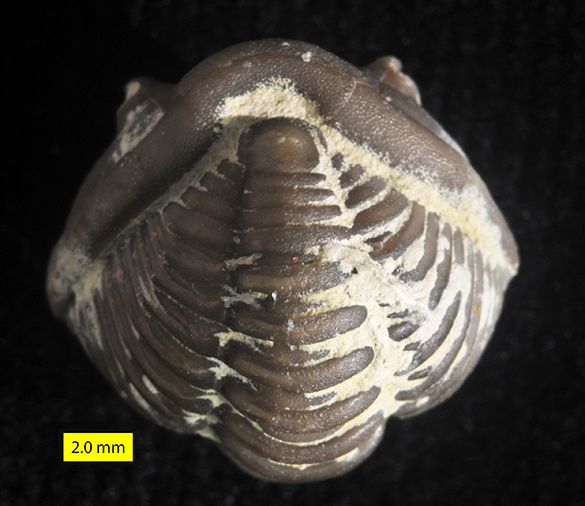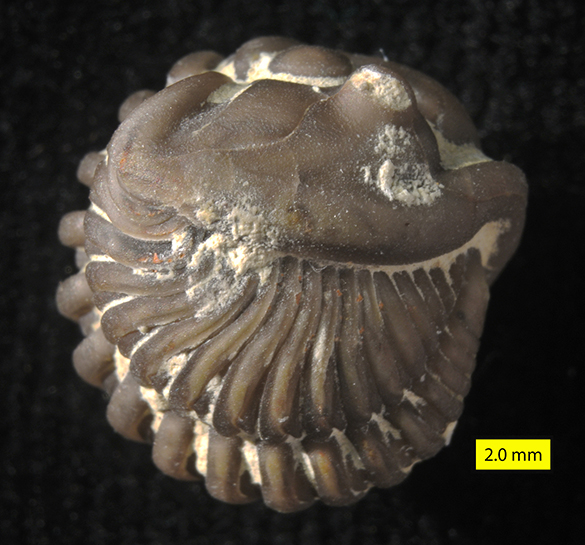 This beautiful specimen was collected by Wooster student Eve Caudill on this year’s College of Wooster Invertebrate Paleontology field trip to Caesar Creek Lake, Ohio. It is the iconic trilobite Flexicalymene meeki (Foerste, 1910) from a soft, “buttery” shale in the Waynesville Formation (Upper Ordovician). This is one of the most common trilobite species in the world, and it has been photographed thousands of times, so I posed it at an unconventional, rakish angle. We are looking here at the cephalon (head) of the animal. I like the way the remnants of the enclosing sedimentary matrix cling to the low places, highlighting the bumps and ridges. The center of the cephalon shows the distinctive glabella with its side lobes. The stomach of the trilobite was housed underneath it. The two eyes are visible on either side of the glabella, the one on the right split by the slightly-open facial suture used for dividing its exoskeleton during molting (ecdysis).
This beautiful specimen was collected by Wooster student Eve Caudill on this year’s College of Wooster Invertebrate Paleontology field trip to Caesar Creek Lake, Ohio. It is the iconic trilobite Flexicalymene meeki (Foerste, 1910) from a soft, “buttery” shale in the Waynesville Formation (Upper Ordovician). This is one of the most common trilobite species in the world, and it has been photographed thousands of times, so I posed it at an unconventional, rakish angle. We are looking here at the cephalon (head) of the animal. I like the way the remnants of the enclosing sedimentary matrix cling to the low places, highlighting the bumps and ridges. The center of the cephalon shows the distinctive glabella with its side lobes. The stomach of the trilobite was housed underneath it. The two eyes are visible on either side of the glabella, the one on the right split by the slightly-open facial suture used for dividing its exoskeleton during molting (ecdysis).
 This is a view of the pygidium (tail end) of the same Flexicalymene meeki specimen. It is tucked under the leading edge of the cephalon in the classic enrollment position. Trilobites likely enrolled for several reasons, but the primary one was almost certainly to affect a pill-bug-like defense against predators.
This is a view of the pygidium (tail end) of the same Flexicalymene meeki specimen. It is tucked under the leading edge of the cephalon in the classic enrollment position. Trilobites likely enrolled for several reasons, but the primary one was almost certainly to affect a pill-bug-like defense against predators.
 This is a side view of the enrolled trilobite. The articulated segments between the cephalon and pygidium constitute the thorax.
This is a side view of the enrolled trilobite. The articulated segments between the cephalon and pygidium constitute the thorax. We met the author of Flexicalymene meeki four years ago in this blog, so let’s visit him again. August F. Foerste (1862-1936) was one of the pioneers of Cincinnatian paleontology and stratigraphy. He grew up and worked in the Dayton, Ohio, area. Foerste went to Denison University where he was a very successful undergraduate, publishing several geological papers. He returned to Dayton after graduation with a PhD from Harvard, teaching high school for 38 years. When he retired he was offered a teaching position at the University of Chicago, but instead went to work at the Smithsonian Institution until the end of his life.
We met the author of Flexicalymene meeki four years ago in this blog, so let’s visit him again. August F. Foerste (1862-1936) was one of the pioneers of Cincinnatian paleontology and stratigraphy. He grew up and worked in the Dayton, Ohio, area. Foerste went to Denison University where he was a very successful undergraduate, publishing several geological papers. He returned to Dayton after graduation with a PhD from Harvard, teaching high school for 38 years. When he retired he was offered a teaching position at the University of Chicago, but instead went to work at the Smithsonian Institution until the end of his life.
A final note from the Invertebrate Paleontology class this year: We were greatly assisted by two fantastic paleontological websites, one by Alycia Stigall at Ohio University called The Digital Atlas of Ordovician Life, and the other by Steve Holland at the University of Georgia titled The Stratigraphy and Fossils of the Upper Ordovician near Cincinnati, Ohio. Thank you to my most excellent and productive colleagues.
References:
Brandt, D.S. 1993. Ecdysis in Flexicalymene meeki (Trilobita). Journal of Paleontology 67: 999-1005.
Brett, C.E., Thomka, J.R., Schwalbach, C.E., Aucoin, C.D. and Malgieri, T.J. 2015. Faunal epiboles in the Upper Ordovician of north-central Kentucky: Implications for high-resolution sequence and event stratigraphy and recognition of a major unconformity. Palaeoworld 24: 149-159.
Esteve, J., Hughes, N.C. and Zamora, S. 2011. Purujosa trilobite assemblage and the evolution of trilobite enrollment. Geology 39: 575-578.
Evitt, W.R. and Whittington, H.B. 1953. The exoskeleton of Flexicalymene (Trilobita). Journal of Paleontology 27: 49-55.
Foerste, A.F. 1910. Preliminary notes on Cincinnatian and Lexington fossils of Ohio, Indiana, Kentucky, and Tennessee. Denison University Science Laboratories Bulletin 16: 17-87.
Frey, R.C. 1987. The paleoecology of a Late Ordovician shale unit from southwest Ohio and southeastern Indiana. Journal of Paleontology 61: 242-267.


